Optimization of the Heating Element in a Gas-Gas Heater Using an Integrated Analysis Model
Abstract
:1. Introduction
2. Research Method
2.1. Numerical Investigation with the Integrated Analysis Model
2.1.1. Integrated Analysis Model
2.1.2. Simulation Setup
2.2. Optimization of Heating Element
3. Results and Discussion
3.1. Thermal-Fluid Characteristics
3.2. Optimal Design
4. Conclusions
Acknowledgments
Author Contributions
Conflicts of Interest
Nomenclature
| FGD | flue gas desulfurization system |
| GGH | gas-gas heater |
| Re | Reynolds number |
| u | average velocity of main flow (m/s) |
| hydraulic diameter (m) | |
| RANS | Reynolds averaged Navier-Stokes equations |
| mass flow rate (kg/s) | |
| mass flow rate of untreated region in GGH (kg/s) | |
| the area of heating element’s outlet (m2) | |
| cross section of GGH (m2) | |
| Sm | momentum source (Pa/m) |
| CR1 | linear resistance coefficient (kg/m3) |
| CR2 | quadratic resistance coefficient (kg/m4) |
| U | fluid velocity (m/s) |
| ℎ | heat transfer coefficient between fluid and solid (W/m2 K) |
| K | area porosity tensor (m2/K s) |
| mean total enthalpy (J) | |
| Γe | effective diffusivity (m2/s) |
| S | source term (kg W/m K s) |
| pressure drop (Pa) | |
| length of heating element (mm) | |
| average velocity of fluid at inlet (m/s) | |
| heat flux (W/m2) | |
| temperature (K) | |
| bulk mean temperature (K) | |
| interfacial area density (1/m) | |
| volume porosity | |
| area of solid part in single heating element (m2) | |
| volume of fluid part in single heating element (m3) | |
| sum of the volume for fluid and solid in element(m3) | |
| heat transfer rate (W) | |
| pumping power (W) | |
| mass flow rate through the rotor (kg/s) | |
| heat capacity of fluid (J/kg K) | |
| volume flow rate (m3/s) | |
| RSM | response surface method |
| CCD | center composite design |
| LHS | latin hypercube sampling method |
| OLHS | optimal latin hypercube sampling method |
| P1 | pitch 1 (mm) |
| P2 | pitch 2 (mm) |
| t | thickness (mm) |
| H | height of corrugated profile (mm) |
| fluctuation of velocity (m/s) | |
| initial time (s) | |
| final time (s) | |
| non-dimensional plate angle | |
| non-dimensional undulation angle | |
| non-dimensional pitch 1 | |
| area average heat transfer coefficient | |
| average performance | |
| x | coordinate in the x-direction |
| y | coordinate in the y-direction |
| z | coordinate in the z-direction |
| Greek Symbols | |
| density (kg/m3) | |
| viscosity (Pa s) | |
| γ | volume porosity |
| performance of GGH | |
| α | plate angle (°) |
| β | undulation angle (°) |
References
- Han, Y.; Xu, C.; Xu, G.; Zhang, Y.; Yang, Y. An Improved Flexible Solar Thermal Energy Integration Process for Enhancing the Coal-Based Energy Efficiency and NOx Removal Effectiveness in Coal-Fired Power Plants under Different Load Conditions. Energies 2017, 10, 1485. [Google Scholar] [CrossRef]
- Nolan, P.S. Flue gas desulfurization technologies for coal-fired power plants. In Proceedings of the Coal-Tech 2000 International Conference, Jakarta, Indonesia, 13 November 2000; Jiang, M.X., Ed.; The Babcock & Wilcox Company: Barberton, OH, USA, 2000. [Google Scholar]
- Stasiekn, J.; Collins, M.W.; Ciofalo, M.; Chew, P.E. Investigation of flow and heat transfer in corrugated passages-1. Experimental results. Int. J. Heat Mass Transf. 1996, 39, 149–164. [Google Scholar] [CrossRef]
- Mallikarjuna, V.; Jashuva, N.; Reddy, B. Improving boiler efficiency by using air preheater. Int. J. Adv. Res. Eng. Appl. Sci. 2014, 3, 11–24. [Google Scholar]
- Choi, S.; Park, J.; Sohn, H.-S.; Kim, S.; Cho, H. Thermal Characteristics of Tube Bundles in Ultra-Supercritical Boilers. Energies 2016, 9, 779. [Google Scholar] [CrossRef]
- Pan, P.; Chen, H.; Liang, Z.; Zhao, Q. Experimental study on corrosion of steels for flue gas reheaters in a coal-fired power plant. Appl. Therm. Eng. 2016. [Google Scholar] [CrossRef]
- Chen, H.; Pan, P.; Shao, H.; Wang, Y.; Zhao, Q. Corrosion and viscous ash deposition of a rotary air preheater in a coal-fired power plant. Appl. Therm. Eng. 2017, 113, 373–385. [Google Scholar] [CrossRef]
- Massoudi, M.; Kim, J.; Wang, P. On the Heat Flux Vector and Thermal Conductivity of Slags: A Brief Review. Energies 2016, 9, 27. [Google Scholar] [CrossRef]
- Wang, P.; Massoudi, M. Slag Behavior in Gasifiers Part I: Influence of Coal Properties and Gasification Conditions. Energies 2013, 6, 784–806. [Google Scholar] [CrossRef]
- Yan, M.; Fu, P.; Chen, Q.; Wang, Q.; Zeng, M.; Pandit, J. Electrical Performance and Carbon Deposition Differences between the Bi-Layer Interconnector and Conventional Straight Interconnector Solid Oxide Fuel Cell. Energies 2014, 7, 4601–4613. [Google Scholar] [CrossRef]
- Kazi, S.N. Fouling and Fouling Mitigation on Heat Exchanger Surfaces; INTECH Open Access Publisher: Rijeka, Croatia, 2012. [Google Scholar]
- Ciofalo, M.I.; Stasiek, J.; Collins, M.W. Investigation of flow and heat transfer in corrugated passages-2. Numerical simulations. Int. J. Heat Mass Transf. 1996, 39, 165–192. [Google Scholar] [CrossRef]
- Vulloju, S. Analysis of Performance of Ljungstrom Air Preheater Elements. Int. J. Curr. Eng. Technol. 2013, 2501–2505. [Google Scholar] [CrossRef]
- Guo-Yan, Z.; Shan-Tung, T.; Hu-Gen, M. Numerical and Experimental Study on the Heat Transfer and Pressure Drop of Compact Cross-Corrugated Recuperators. J. Heat Transf. 2014, 136, 071801. [Google Scholar] [CrossRef]
- Hwang, S.D.; Jang, I.H.; Cho, H.H. Experimental study on flow and local heat/mass transfer characteristics inside corrugated duct. Int. J. Heat Fluid Flow 2006, 27, 21–32. [Google Scholar] [CrossRef]
- Kwon, H.G.; Hwang, S.D.; Cho, H.H. Flow and heat/mass transfer in a wavy duct with various corrugation angles in two dimensional flow regimes. Heat Mass Transf. 2008, 45, 157–165. [Google Scholar] [CrossRef]
- Hwang, S.D.; Kwon, H.G.; Cho, H.H. Heat transfer with dimple/protrusion arrays in a rectangular duct with a low Reynolds number range. Int. J. Heat Fluid Flow 2008, 29, 916–926. [Google Scholar] [CrossRef]
- Wang, H.Y.; Zhao, L.L.; Xu, Z.G.; Chun, W.G.; Kim, H.T. The study on heat transfer model of tri-sectional rotary air preheater based on the semi-analytical method. Appl. Therm. Eng. 2008, 28, 1882–1888. [Google Scholar] [CrossRef]
- Sanaye, S.; Jafari, S.; Ghaebi, H. Optimum operational conditions of a rotary regenerator using genetic algorithm. Energy Build. 2008, 40, 1637–1642. [Google Scholar] [CrossRef]
- Cai, M.; Hui, S.E.; Wang, X.; Zhao, S.; He, S. A study on the direct leakage of rotary air preheater with multiple seals. Appl. Therm. Eng. 2013, 59, 576–586. [Google Scholar] [CrossRef]
- Maharaj, A.; Schmitz, W.; Naidoo, R.; Jestin, L.; Fuls, W.; Pronobis, M. A numerical study of air preheater leakage. Energy 2015, 92, 87–99. [Google Scholar] [CrossRef]
- Heidari-Kaydan, A.; Hajidavalloo, E. Three-dimensional simulation of rotary air preheater in steam power plant. Appl. Therm. Eng. 2014, 73, 399–407. [Google Scholar] [CrossRef]
- Dallaire, J.; Gosselin, L.; da Silva, A.K. Conceptual optimization of a rotary heat exchanger with a porous core. Int. J. Therm. Sci. 2010, 49, 454–462. [Google Scholar] [CrossRef]
- Alhusseny, A.; Turan, A. An effective engineering computational procedure to analyse and design rotary regenerators using a porous media approach. Int. J. Heat Mass Transf. 2016, 95, 593–605. [Google Scholar] [CrossRef]
- Lee, Y.M.; Chung, H.; Kim, S.H.; Bae, H.S.; Cho, H.H. Optimal Design of Heating Element to Enhance Thermal Performance in Gas-Gas Heater. In Proceedings of the 2nd Thermal and Fluid Engineering Conference and 4th International Workshop on Heat Transfer, Las Vegas, NV, USA, 2–5 April 2017; pp. 3383–3386. [Google Scholar]
- Myers, R.H.; Montgomery, D.C.; Anderson-Cook, C.M. Response Surface Methodology: Process and Product Optimization Using Designed Experiments, 3rd ed.; Wiley Series in Probability and Statistics; Wiley: Hoboken, NJ, USA, 2009; ISBN 978-0-470-17446-3. [Google Scholar]
- Lautenschlager, U.; Eschenauer, H.A.; Mistree, F. Design-of-Experiments Methods and their Application to Robust Multicriteria Optimization Problems. ZAMM-J. Appl. Math. Mech. Z. Angew. Math. Mech. 1999, 79, 71–74. [Google Scholar] [CrossRef]
- McKay, M.D. Latin hypercube sampling as a tool in uncertainty analysis of computer models. In Proceedings of the 24th conference on Winter simulation, New Orleans, LA, USA, 9–12 December 1990; pp. 557–564. [Google Scholar]
- Van der Velden, A.; Koch, P. Isight design optimization methodologies. ASM Handb. 2010, 22, 79. [Google Scholar]
- Cho, H.-H.; Kim, Y.Y.; Rhee, D.-H.; Lee, S.Y.; Wu, S.J.; Choi, C.K. The effects of gap position in discrete ribs on local heat/mass transfer in a square duct. J. Enhanc. Heat Transf. 2003, 10, 287–300. [Google Scholar] [CrossRef]
- Cho, H.H.; Lee, S.Y.; Rhee, D.H. Effects of cross ribs on heat/mass transfer in a two-pass rotating duct. Heat Mass Transf. 2004, 40, 743–755. [Google Scholar] [CrossRef]
- Kim, K.M.; Kim, S.I.; Jeon, Y.H.; Lee, D.H.; Cho, H.H. Detailed Heat/Mass Transfer Distributions in a Rotating Smooth Channel with Bleed Flow. J. Heat Transf. 2007, 129, 1538. [Google Scholar] [CrossRef]
- Kim, K.M.; Lee, D.H.; Cho, H.H. Pressure drop and thermal performance in rotating two-pass ducts with various cross rib arrangements. Heat Mass Transf. 2008, 44, 913–919. [Google Scholar] [CrossRef]
- Park, J.S.; Kim, K.M.; Lee, D.H.; Cho, H.H.; Chyu, M. Heat Transfer in Rotating Channel With Inclined Pin-Fins. J. Turbomach. 2011, 133, 021003. [Google Scholar] [CrossRef]
- Chung, H.; Park, J.S.; Park, S.; Choi, S.M.; Rhee, D.-H.; Cho, H.H. Augmented heat transfer with intersecting rib in rectangular channels having different aspect ratios. Int. J. Heat Mass Transf. 2015, 88, 357–367. [Google Scholar] [CrossRef]
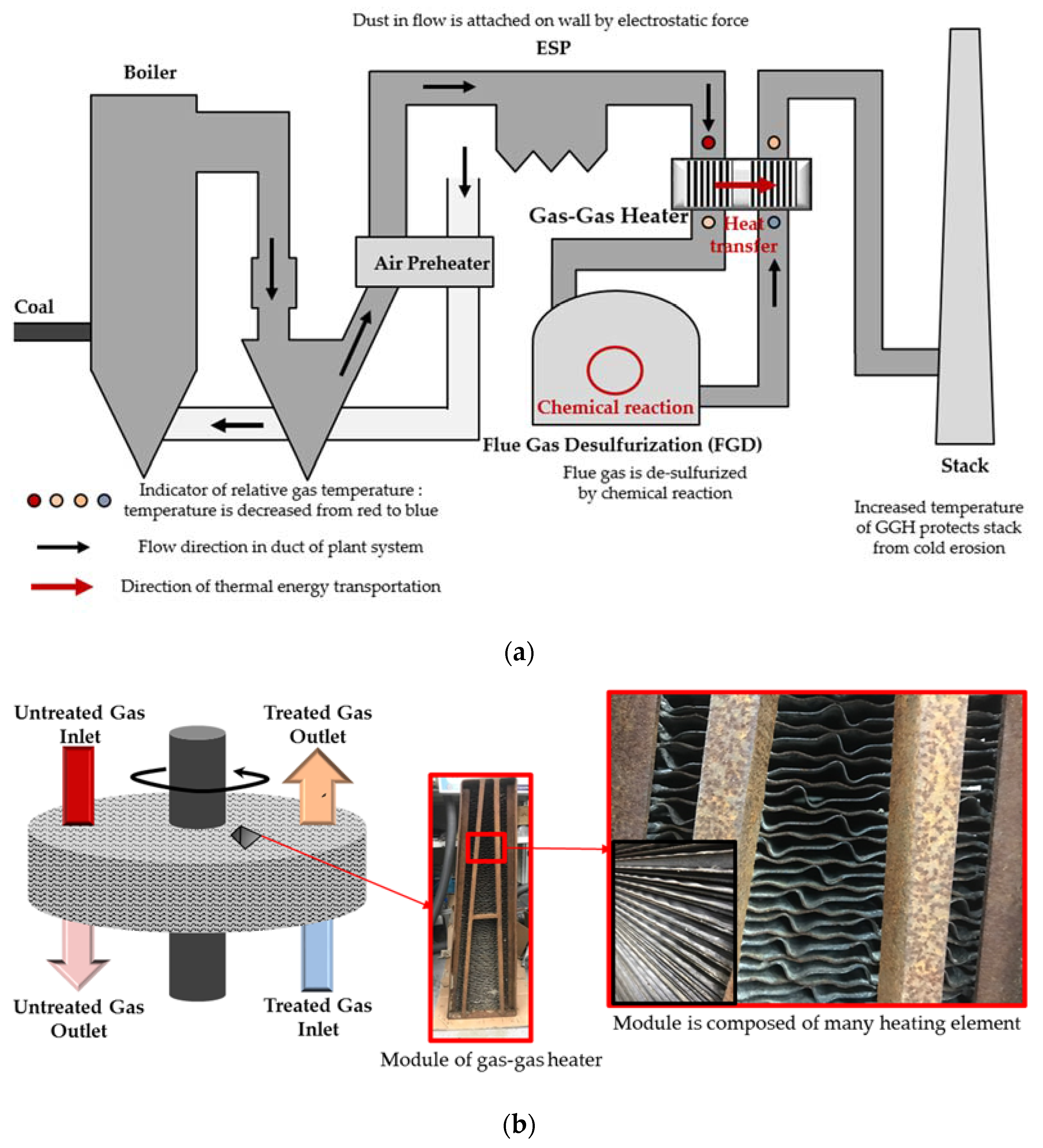

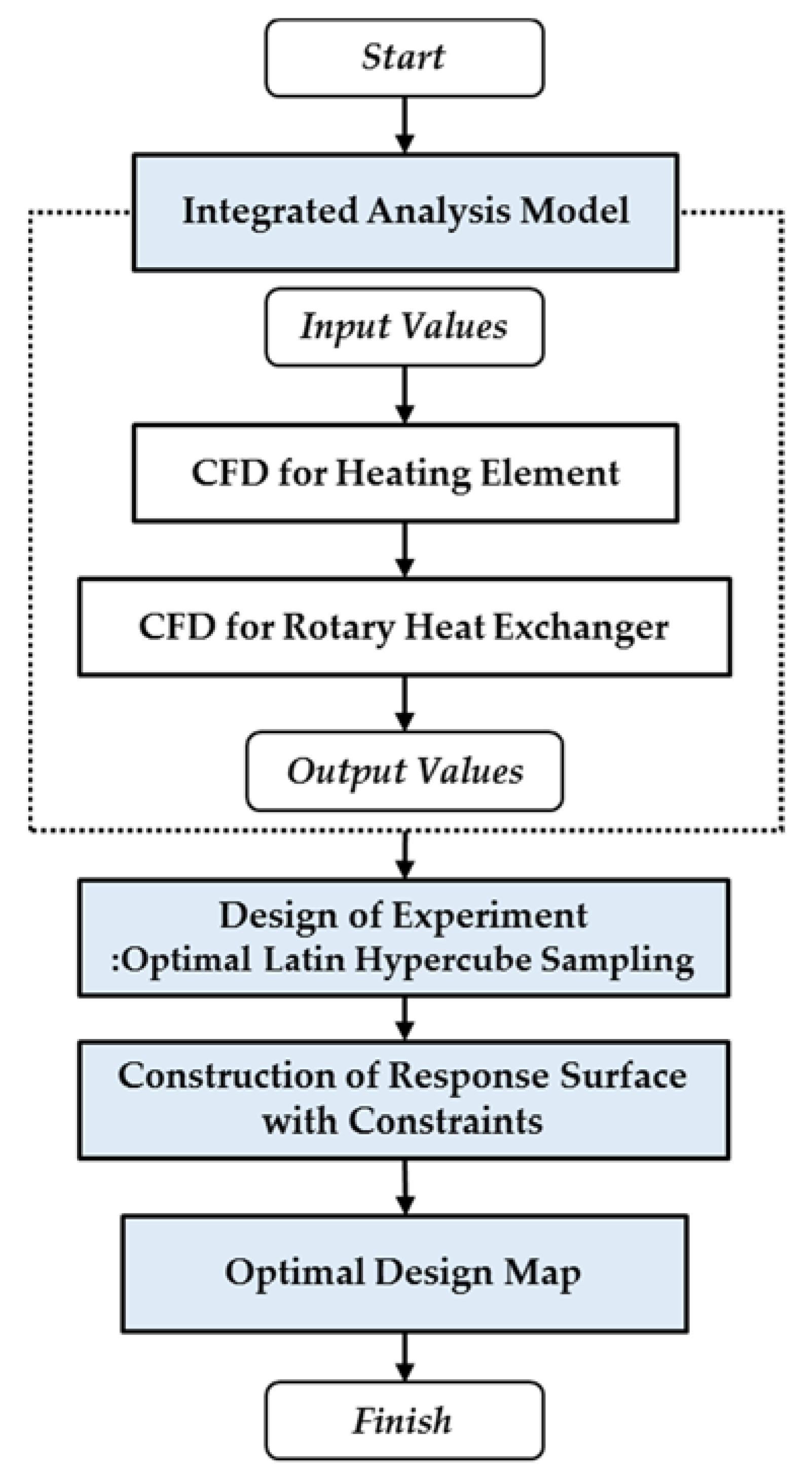
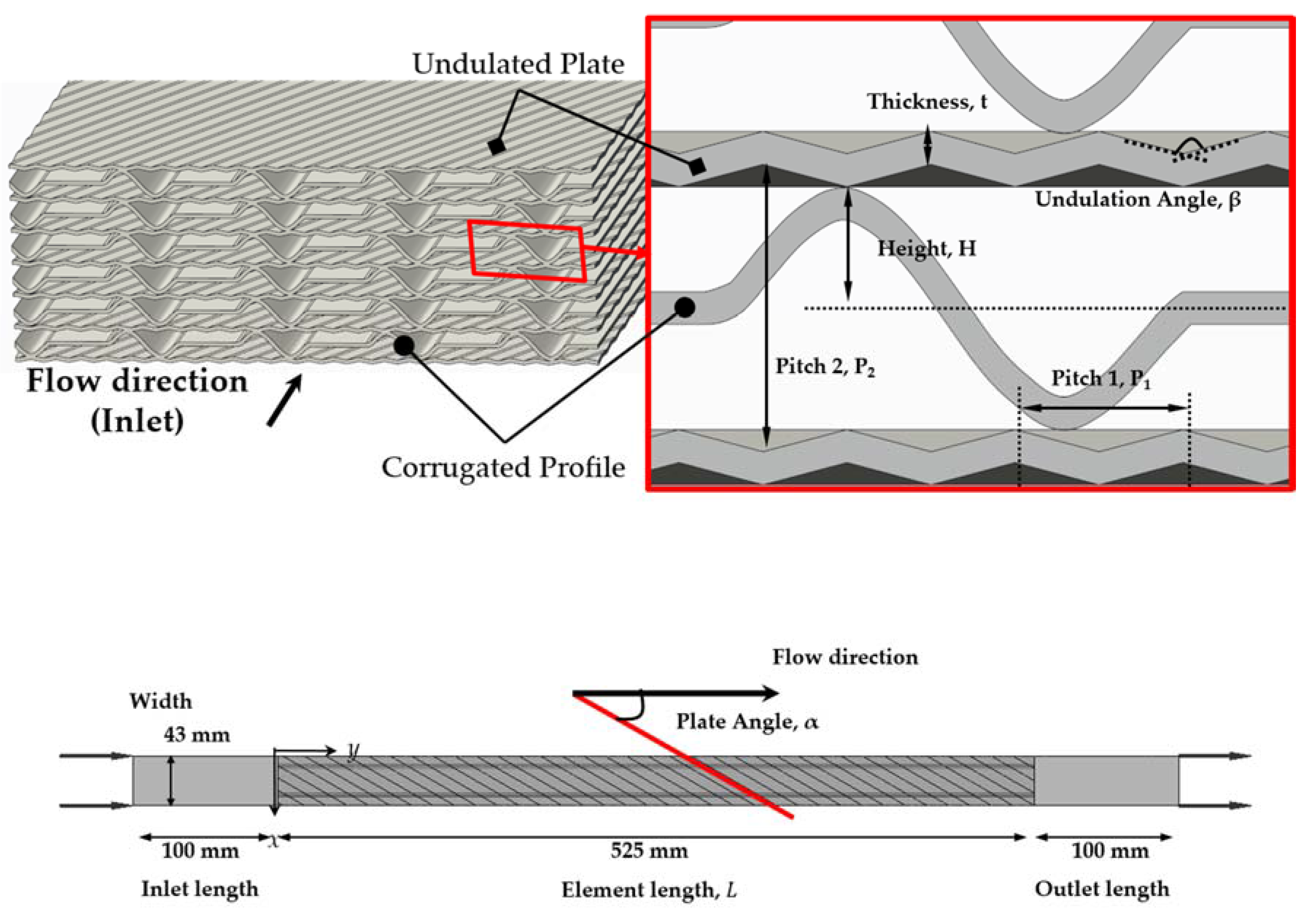

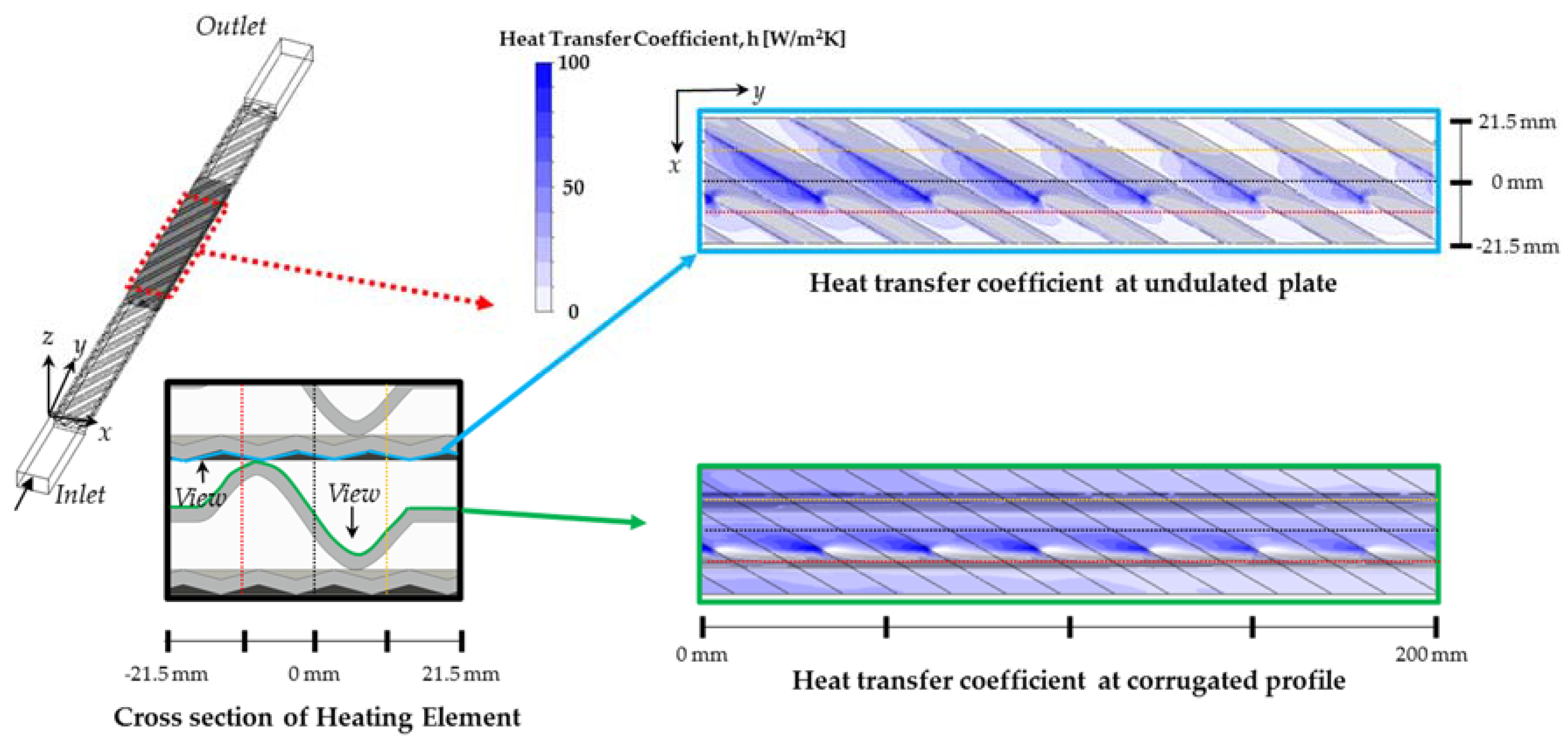



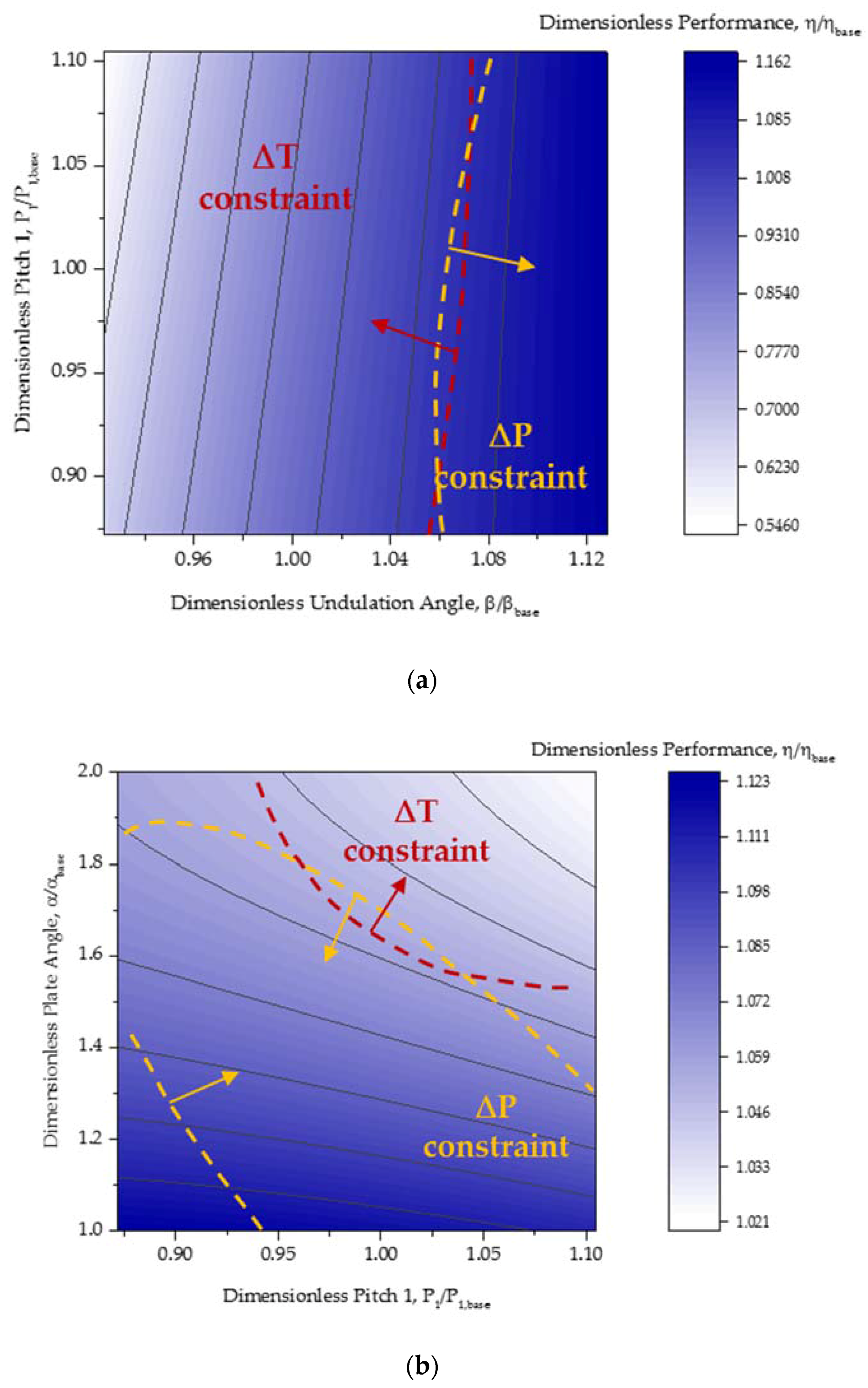
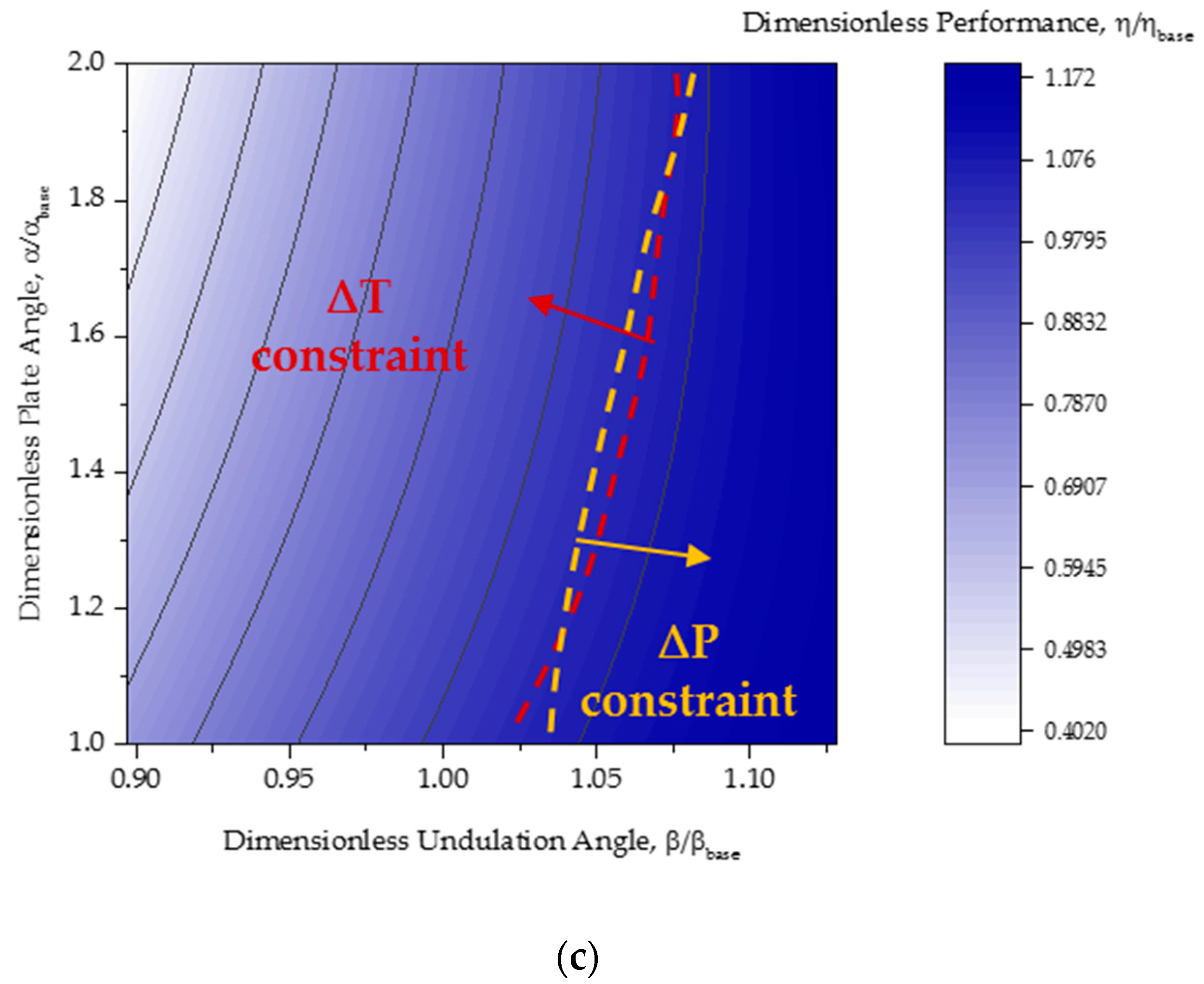
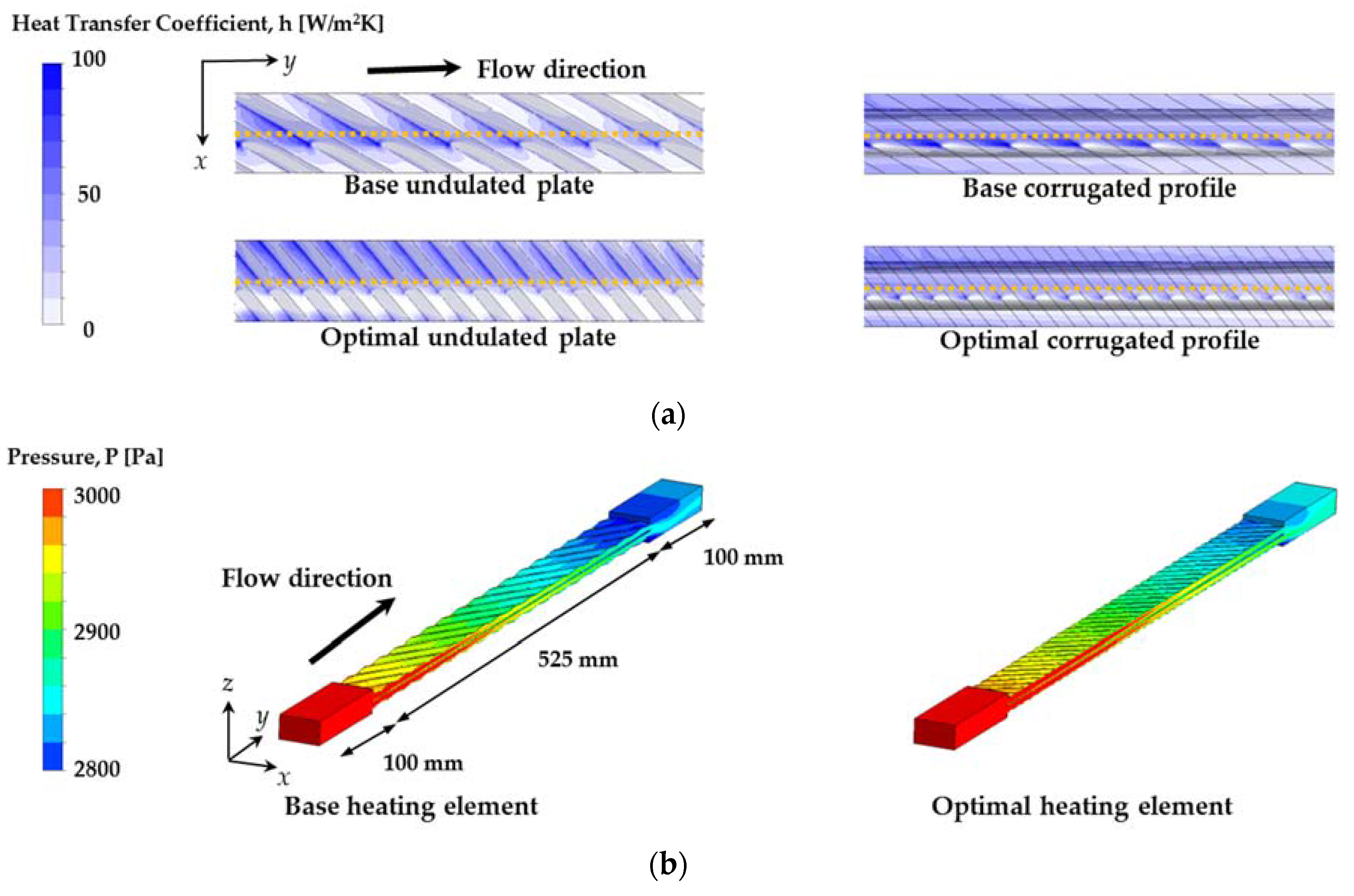

| Parameters | Units | Lower Bound | Base | Upper Bound |
|---|---|---|---|---|
| Plate angle, α | 30 | 30 | 60 | |
| Undulation angle, β | 72 | 78 | 90 | |
| Pitch 1, P1 | mm | 15 | 17.2 | 19 |
| Pitch 2, P2 | mm | - | 12.6 | - |
| Element length, L | mm | - | 525 | - |
| Thickness, t | mm | - | 1.2 | - |
| Target | Grids | Values | Error [%] |
|---|---|---|---|
| Heating Element (Friction Coefficient, kg/m4) | 3.58992 × 106 | 2.60217 | 21.2 |
| 6.86075 × 106 | 2.35021 | 9.50 | |
| 1.42655 × 107 | 2.16611 | 0.93 | |
| 2.01201 × 107 | 2.14663 | 0.02 | |
| 2.18297 × 107 | 2.14624 | - | |
| GGH system (Average Performance) | 1.14401 × 106 | 53.52307 | 12.0 |
| 1.52084 × 106 | 57.8901 | 4.82 | |
| 1.65237 × 106 | 59.37745 | 2.38 | |
| 1.92192 × 106 | 60.7366 | 0.14 | |
| 6.50828 × 106 | 60.82319 | - |
| Target | Object | Base Design | Optimal Design |
|---|---|---|---|
| Heating Element | Area average heat transfer coefficient, | 35.07 W/m2 K | 34.04 W/m2 K |
| Friction coefficient, | 2.75 kg/m4 | 2.37 kg/m4 | |
| Interfacial area density, IAD | 315/m | 322/m | |
| Volume porosity, VP | 0.68 | 0.74 | |
| GGH system | Average pressure drop at untreated region | 220 Pa | 198 Pa |
| Average pressure drop at treated region | 357 Pa | 335 Pa | |
| Average temperature change at untreated region | 16.3 K | 15.9 K | |
| Average temperature change at treated region | 15.6 K | 15.4 K | |
| Average performance, | 60.7 | 65.4 |
© 2017 by the authors. Licensee MDPI, Basel, Switzerland. This article is an open access article distributed under the terms and conditions of the Creative Commons Attribution (CC BY) license (http://creativecommons.org/licenses/by/4.0/).
Share and Cite
Lee, Y.M.; Chung, H.; Kim, S.H.; Bae, H.S.; Cho, H.H. Optimization of the Heating Element in a Gas-Gas Heater Using an Integrated Analysis Model. Energies 2017, 10, 1932. https://doi.org/10.3390/en10121932
Lee YM, Chung H, Kim SH, Bae HS, Cho HH. Optimization of the Heating Element in a Gas-Gas Heater Using an Integrated Analysis Model. Energies. 2017; 10(12):1932. https://doi.org/10.3390/en10121932
Chicago/Turabian StyleLee, Young Mun, Heeyoon Chung, Seon Ho Kim, Hyeng Sub Bae, and Hyung Hee Cho. 2017. "Optimization of the Heating Element in a Gas-Gas Heater Using an Integrated Analysis Model" Energies 10, no. 12: 1932. https://doi.org/10.3390/en10121932




